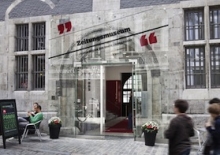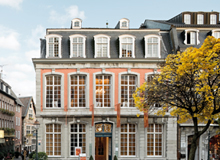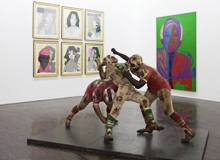The oldest drawings in the collection are medieval miniatures and antiphonary pages from the time between 1330 and 1500, including six from the succession of Johannes von Valkenburg in Cologne. In terms of works of the Mannerism and Baroque periods, Dutch drawings from the 17th century make up the greater part of the collection.
The 18th century is amply represented by a large collection of more than 600 architectural drawings and plans by Johann Joseph Couven and his son Jakob. Examples of 19th century works include drawings and numerous studies for the Aachen Town Hall frescoes by the Aachen-born artist Alfred Rethel, but also more than 50 aquarelles and gouaches by the Aachen-born Romantic artist and Schirmer pupil Caspar Scheuren.
Classical Modernism as represented by a few individual drawings. These include a permanent loan from a private collection of 19 aquarelles, gouaches and coloured chalk drawings. Some gouaches and drawings from the second half of the 20th century are by artists from the region and include several works by Herbert Falken.
One of the main focuses of the print section of the collection is on German prints from the 15th and 16th century with numerous pages by Albrecht Dürer and his contemporaries.
But the collection is also amply stocked with Dutch and Flemish prints from the 16th and 17th century. These include 32 etchings by Rembrandt as well as numerous copperplates from the engraving workshop of Peter Paul Rubens.
The collection also boasts solitaires in the form of a rare first edition of the Carceri drawings of Giovanni Battista Piranesi as well as first editions of Goya's famous four series of etchings as bound editions: the Caprichos, the Desastres de la Guerra, the Tauromaquia and the Proverbios.
The 19th century is represented by prints from English and French painter-etchers and several German impressionists. Six print cycles by Max Klinger (Rescues of Ovidian Victims, Eve and the Future, Intermezzi, A Love, Brahms Fantasy, Of Death Part Two) and a collection of works by German expressionists exemplify the graphic art of the late 19th and early 20th century.
Due to their photosensitivity, the objects are not on show in the permanent collection.
On request, we can gladly set out selected works of the collection of prints and drawings for perusal in our library.

Medienmuseum, Wechselausstellungen und eine Sammlung von 200.000 Zeitungen und Druckwerken in nahezu allen Sprachen.

Das bekannteste Wohnzimmer Aachens, mit anschaulichen Einblicken in die Wohnkultur des 18. und frühen 19. Jahrhunderts.

UNESCO-Weltkulturerbe mit herausragender künstlerischer Ausstattung: Karlsschrein, aufwändigen Mosaiken, einer goldenen Altartafel.

Die größten Historienbilder der Romantik, originalgetreue Kopien des Säbels Karls des Großen, einer karolingischen Handschrift, der Reichskrone.

Kunst von der Gegenwart bis in die Antike, mit hervorragenden Gemälden und Skulpturen des Spätmittelalters sowie der Malerei des 17. Jhs.

Schauplatz für zeitgenössische Künstler und Kunstwerke, Begegnungsstätte darstellender und bildender Kunst, Bestände der Sammlung Ludwig.

Lebendiges Zentrum zur Erinnerung der Grenzgeschichte und -geschichten, mit verbotenen Souvenirs und Schwarzbrennerei.

Eröffnung 2014 – Lebendige Geschichte von den Karolingern bis heute. Ausgangspunkt der Route Charlemagne am historischen Katschhof.

Stolz blicken die Aachener auf ihre Geschichte als römische Bäderstadt und Kaiserresidenz Karls des Großen zurück. Der Dom, 1978 zum ersten UNESCO Weltkulturerbe in Deutschland ernannt, und das Rathaus bilden den Mittelpunkt der Stadt. In den Gassen der Altstadt erzählen viele historische Gebäude von der lebhaften Geschichte der Stadt, und doch ist die Zeit nicht stehen geblieben.
An der „Eliteuni“ RWTH Aachen und den anderen Hochschulen sind rund 40.000 Studenten eingeschrieben. Das junge Leben pulsiert vor allem im Pontviertel, dem beliebten Ausgehviertel mit seinen zahlreichen Cafés, Kneipen und Restaurants. Doch auch in den Gassen und auf den Plätzen der Altstadt ist immer viel los. Rund um Dom und Rathaus laden zahlreiche Einzelhändler ebenso wie Filialen namhafter Häuser zum Bummeln ein.
Quelle allen Ruhms ist das Wasser: Die Heilkraft der heißen Thermalquellen war ausschlaggebend dafür, dass Kaiser Karl Aachen zu seiner Lieblingsresidenz machte. Die Badetradition wird heute durch die Carolus Thermen Bad Aachen weitergeführt.
Wer sich lieber in der Natur entspannt, hat dafür zahlreiche Möglichkeiten, etwa im nahe gelegenen Nationalpark Eifel. Zudem locken mehrere Theater und Museen mit einem vielschichtigen Angebot.

